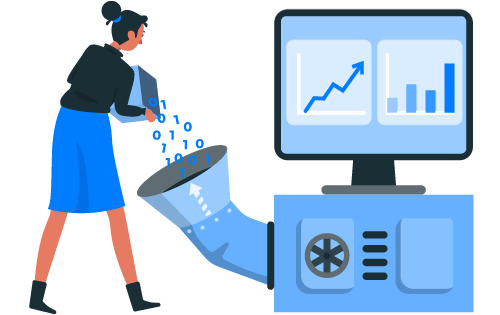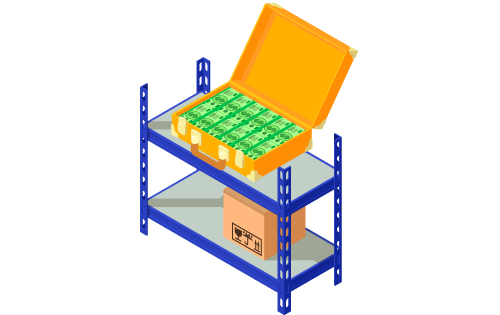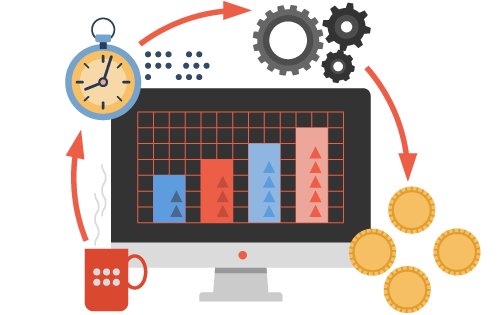Making Low Stock Levels (And Overstocking) a Thing of the Past
Built For



Making Low Stock Levels (And Overstocking) a Thing of the Past
Purchasing and managing inventory can feel like a tightrope walk. Lean too far one way, and you’re left scrambling to fulfill orders with shelves running bare. Lean too far the other, and you’re drowning in excess stock that eats up valuable storage space and ties up cash. Finding the perfect balance between low stock levels and overstocking can be tricky, but it’s also vital in running a smooth and profitable operation.
In this article, we’ll explore how you can say goodbye to stock shortages and overstocking issues once and for all. By leveraging inventory software, reorder alerts, and implementing best practices, you can keep your stock levels right, ensuring you meet customer demand while avoiding costly excess.
The Impact of Low Stock Levels
Running out of stock at the wrong time can quickly become a nightmare for any business. Low stock levels affect not only your ability to fulfill customer orders, but also your reputation. Imagine this: a loyal customer orders a product they rely on, only to find it’s out of stock. That one lost sale can lead to a string of missed opportunities and dissatisfied customers, all because your inventory wasn’t up to date.
Low stock levels also disrupt your internal operations. Production schedules can be thrown off when you don’t have enough raw materials on hand, forcing you to pause manufacturing or scramble for alternatives. Not only does this affect timelines, but it also impacts supplier relationships. Suppliers need to know when and how much to deliver, and inconsistent orders due to low stock can lead to delays and frustration.
Consistently running low on stock limits your ability to grow. Without enough inventory to meet demand, potential sales are lost, and you might find yourself constantly playing catch-up, spending more time fixing the problem than planning for success. By keeping stock levels optimized, you’ll avoid these issues and ensure your business runs smoothly.
The Costs of Overstocking

On the flip side, having too much inventory can weigh your business down. Overstocking isn’t just about having extra products sitting on the shelves—it’s about the hidden costs that pile up over time. Storing excess inventory means paying more for warehouse space, utilities, and even insurance. That storage space could be better used for products that actually move, but instead, it’s filled with items costing you more the longer they sit.
Overstocking can also lead to a more painful problem: obsolete stock. Trends shift, seasons change, and certain products can lose their appeal. The result? You’re stuck with items that are no longer in demand, forcing you to sell them at a discount or write them off completely. It’s a quick way to drain profit margins and reduce overall revenue.
Let’s not forget the impact on cash flow. When you tie up money in excess inventory, you have less capital for other areas of your business, like marketing, new product development, or improving customer service. Instead of reinvesting in growth, you’re dealing with inventory that may not sell quickly – or at all.
By finding a balance and avoiding overstocking, your business can stay lean and agile, ready to respond to market changes and customer needs without wasting resources.
Using Inventory Software to Maintain Optimal Stock Levels
One of the best tools in your inventory management arsenal is software that helps you monitor stock levels in real time. Instead of manually checking your inventory or guessing when you’re running low, inventory software can do the heavy lifting by monitoring your stock and providing reorder alerts.
Reorder alerts act as an early warning system. When your stock for an item dips below a set threshold, the software sends an alert, giving you plenty of time to restock before you run out. This feature ensures you can stay proactive, avoiding the chaos of last-minute orders or frustrating stockouts.
Additionally, with reorder alerts, you’re not just responding to low stock levels—you can plan ahead. The software analyzes trends in your sales and purchasing history, helping you adjust reorder points based on accurate data. This way, your inventory stays aligned with actual demand, ensuring you have what you need when you need it without overstocking.
By utilizing inventory software with reorder alerts, you can strike the perfect balance between too much and too little, ensuring your operations run smoothly and efficiently.
One-Click Purchase Orders

When it comes to replenishing your stock, simplicity is key. That’s where the power of one-click purchase orders comes into play. With inventory management software, you can create and send purchase orders to your suppliers with just a single click—eliminating the need for tedious, time-consuming paperwork.
One-click purchase orders streamline the entire restocking process. Instead of manually compiling lists of what needs to be ordered, the software automatically generates the necessary purchase orders based on your current stock levels and reorder alerts. Once you review the suggested order, it’s just one click, and the order is on its way to your supplier.
Quick purchase orders save time and reduce the risk of human error. You’re less likely to overlook essential items or accidentally order the wrong quantities. Plus, with all your orders stored digitally, tracking and managing past and current orders becomes much easier.
One-click purchase orders help you keep your inventory levels where they need to be while making the whole process faster, more accurate, and hassle-free.
Improving Visibility and Accuracy with Barcoding and Tracking
When managing stock, guesswork is the last thing you want. Many businesses are turning to barcoding integrated with inventory and order management software to enhance visibility and accuracy across their inventory. With barcoding, you can quickly scan items in and out of your warehouse, tracking and recording every movement in real time.
Using barcode scanners, each product or item gets a unique identifier tied directly to your inventory management system. When you receive new stock, fulfill an order, or move items within your facility, those actions are logged instantly. As a result, you get real-time data on your stock levels, helping you avoid issues like stock discrepancies, overstocking, or running out of critical products.
Barcoding and tracking also reduce manual entry errors. Without the need to manually input numbers or write down stock movements, you significantly reduce the chances of mistakes that can lead to inaccurate inventory counts. This boosts accuracy and speeds up your operations, saving valuable time and resources.
Adopting barcoding and tracking technology gives you a clearer picture of your inventory and ensures that your stock data is always up-to-date and reliable.
Best Practices for Preventing Stock Issues

Preventing stock issues—whether running low on critical items or drowning in excess inventory—requires strategic planning and reliable tools. By implementing key best practices, you can ensure that your stock levels stay balanced and your business remains efficient.
Set Clear Reorder Points
One of the easiest ways to prevent stock shortages is by setting clear reorder points in your inventory software. This ensures that as soon as stock dips below a certain level, you’ll receive a timely notification to reorder, allowing you to restock before you run out.
Conduct Regular Inventory Audits
Regularly auditing your inventory—through full physical or cycle counts—helps catch discrepancies and keeps your stock data accurate. Performing periodic checks ensures your records reflect reality, reducing the chances of stock issues.
Analyze Historical Data for Better Forecasting
Look at your past sales and stock data to spot trends. This helps you adjust your stock levels based on seasonality, demand fluctuations, or new product launches. Inventory software can generate reports that make this data easy to interpret and use for better decision-making.
Work Closely with Suppliers
Communicating with your suppliers can help you avoid stock issues. Understanding your suppliers’ lead times and coordinating orders based on your demand can reduce the risk of running out of stock or overordering items that move slowly.
Monitor Slow-Moving Stock
Excess inventory often comes from overordering items that don’t sell as fast as expected. Regularly reviewing your slow-moving stock can help you identify items to clear out before they become obsolete. Implementing discounts or promotions can help move these products and free up space for more in-demand items.
By incorporating these inventory management best practices, you can maintain optimal stock levels and avoid the headaches of both stockouts and overstocking. With the help of inventory management software and a proactive approach, your business can keep its inventory lean, efficient, and ready to meet demand.
Call us at 817-870-1311





